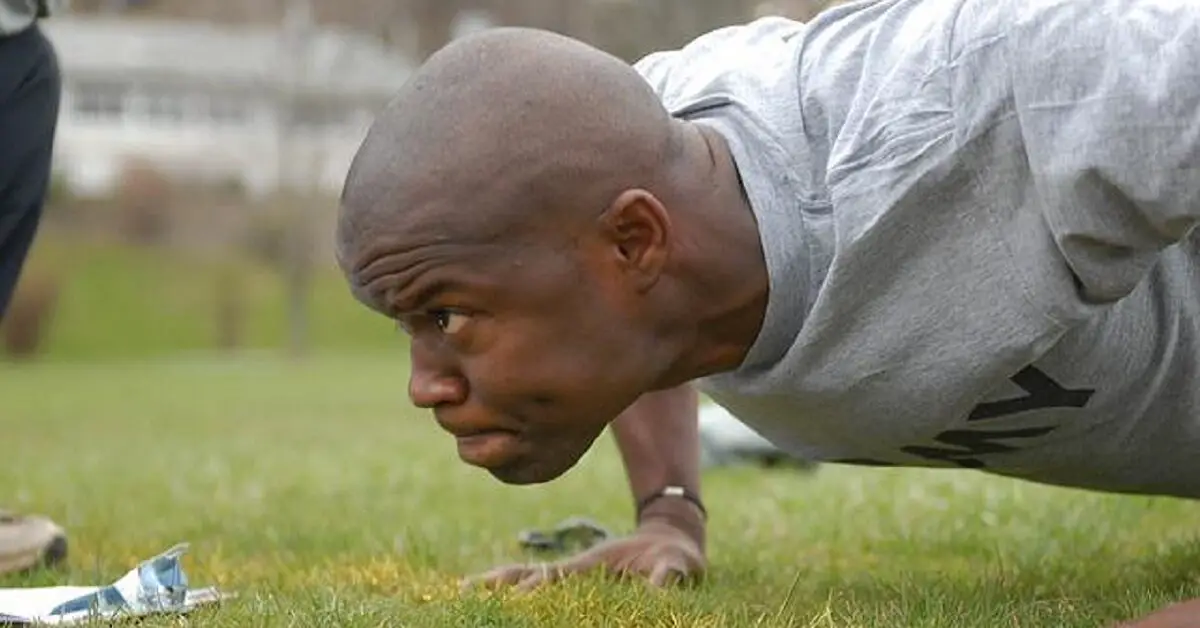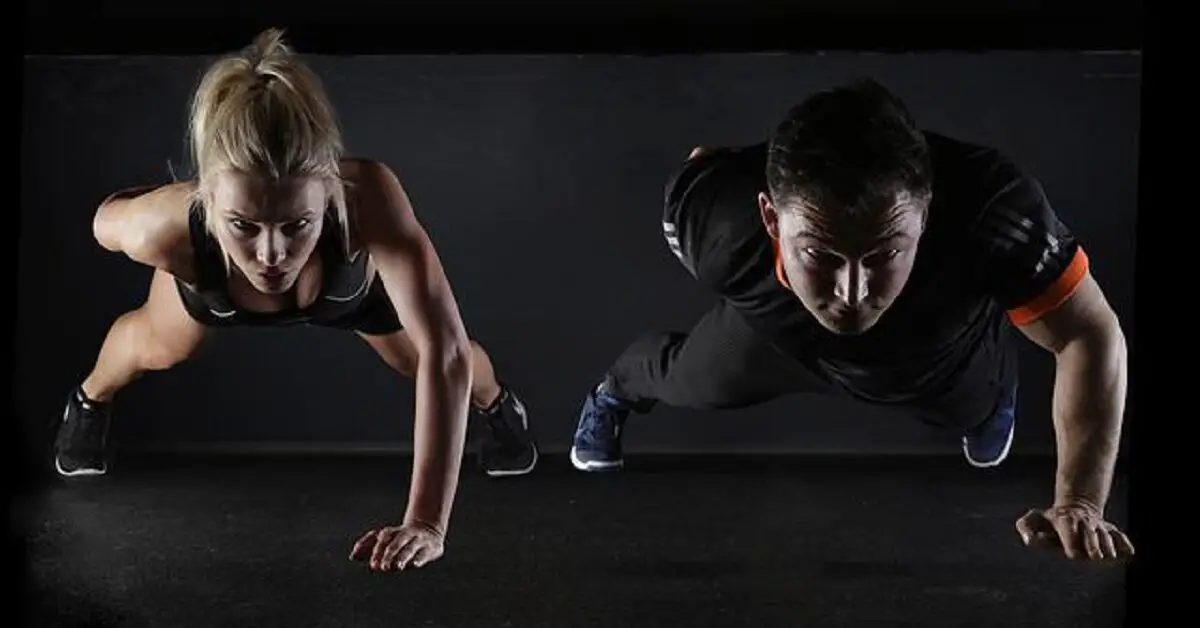
Push-ups are bodyweight exercises that help build upper body strength. If you’ve been wondering how many calories push-ups burn, you can use our Calories Burned By Push-ups Calculator (view our calculator here) to get an estimate.
Our calculator estimates energy expenditure based on your age, sex, height, body weight, workout duration, exercise intensity, and lean body mass (athletes and bodybuilders).
You can also use it to estimate calories burned due to any number of push-up repetitions.
For instance, if you want to know how many calories 100 push-ups burn, enter the number, and the calculator supplies answers that take account of your age, sex, height, weight, workout intensity, duration, and lean mass.
Besides estimating energy consumption, it estimates your Basal Metabolic Rate/Resting Metabolic Rate (kcal per day).
We provide detailed instructions showing you how to calculate energy expenditure by yourself. We also show how to estimate the potential weight (fat) loss due to physical activity.
Contents:
A note on energy expenditure estimates based on formulas
Calories Burned Calculator: Push-ups
Push-ups build upper body strength
How to calculate calories burned: MET values
How to calculate calories burned: What are standard METs?
Standard MET value of push-ups
How to calculate calories burned by push-ups per unit of time
How many calories do 100 push-ups burn?
How to calculate Corrected MET values
Fat or weight loss due to push-ups
A note on energy expenditure estimates based on formulas
Energy expenditure values based on mathematical formulas are only rough estimates intended to give you an idea of the energy costs of physical activity.
They may also give you an idea of the relative effectiveness of different physical activities for burning calories.
The only reliable way to estimate your energy expenditure is through measurement methods such as:
- Direct and indirect calorimetry
- The doubly labeled water technique (DLW)
- Heart rate monitoring
Calories Burned Calculator: Push-ups

If you want to estimate how many calories you burn by performing push-ups, enter your age, sex, weight, height, workout duration, and intensity (moderate or vigorous), and our calculator supplies answers based on ALL the information you provided.
Our calculator also corrects for high lean body mass by using the Katch-McArdle formula to compute your metabolic baseline.
Athletes and bodybuilders with high lean mass and high BMI (view our BMI calculator here) may estimate their energy expenditure by selecting an option that approximates their percent body fat.
If you also want to calculate energy expenditure due to performing any number of reps, such as 100 push-up reps, enter the number in the field provided, and our calculator does the number crunching for you.
According to the CDC, the average person burns more than 7 calories per minute performing push-ups vigorously.
The average, healthy adult male, standing 70 inches (177.8cm) tall and weighing 75kg (165lbs), burns between 5 calories (moderate effort) to about 10.5 calories (vigorous effort) per minute performing push-ups.
The average, healthy adult female, standing 64 inches (163cm) tall and weighing 64kg (140lbs), expends between 4 calories (moderate effort) to about 9 calories (vigorous effort) per minute.
Push-ups build upper body strength

Push-ups are bodyweight or calisthenics exercises that help build upper body and core strength.
The exercise targets the chest, arms, shoulders, upper back, and abdominal muscles.
You perform push-ups face down, your back straight, your upper body supported on your palms (or knuckles), and your lower body on the balls of your feet.
You lower your body by bending your elbows at a 45-degree angle to your torso or centerline (see video below).
When your chest nearly touches the ground, power up explosively.
View a video demonstration of how to perform push-ups here.
There are many different ways to perform the exercise. The video below shows the traditional technique and several variations.
The variations make the exercise easier or more challenging. However, most don’t require any special equipment.
The variation you adopt depends on your level of upper body muscular fitness.
If you are a beginner, you may want to adopt less challenging methods, such as doing the exercise with your knees in contact with the floor.
Incline push-ups in which the upper body is higher than the lower body are also less challenging to perform.
If you want to try more challenging variations, you may add weights to increase resistance.
This video shows you several easy and difficult variations of the basic routine.
Push-ups generally activate the following muscles:
- Arm muscles: The triceps and biceps muscles
- Chest muscles: Pectoral muscles, including pectoralis major and pectoralis minor
- Shoulders: Deltoid muscle and rotator cuff
- Upper back muscles: Trapezius muscle and rhomboids
- Middle back muscles, including latissimus dorsi
- Serratus anterior muscles in the ribs and side of the chest
If you keep a good form, push-ups may also engage your back and core muscles, including abdominal muscles.
How to calculate calories burned: MET values

You can calculate energy expenditure while doing push-ups using this formula:
Calories burned per minute = Metabolic Equivalent of Task (MET) x 3.5 ml/kg/min x (weight in kilograms)/200
The Metabolic Equivalent of Task (MET) is a ratio that compares the rate of oxygen consumption while performing an activity with resting oxygen consumption (also known as Resting Metabolic Rate, RMR).
Researchers use oxygen consumption rates to measure calorie consumption because oxygen reacts with glucose to release energy.
Thus, the rate of oxygen consumption is directly related to calories burned.
You may learn more about the role of oxygen in cell respiration here.
How to calculate calories burned: What are standard METs?
The resting oxygen consumption rate of 3.5ml/kg/min is equivalent to 1 MET. Thus, an activity with a value of 5 METs burns calories at 5 times the resting rate.
The Standard MET value of an activity is the ratio of oxygen consumption rate while performing the activity and a reference value set by convention as the resting oxygen consumption.
The value of 3.5ml/kg/min is the resting oxygen consumption (VO2) set by convention. It was based on the RMR of a 40-year-old male weighing 70kg (Byrne et al., 2005).
Thus, an activity with an oxygen consumption rate (VO2) measured as 30 ml/kg/min will have a Standard MET value calculated as shown below:
(30/3.5 )ml/kg/min = 8.57 METs.
Experts use MET values to measure the relative intensity of various exercises or physical activities. The more intensive a physical activity, the higher its MET value.
The Compendium of Physical Activities classifies physical activities as light, moderate, or vigorous based on MET values (see Table 1).
| Compendium Code | Physical Activity | Intensity | MET value |
| 07020 | Sitting Watching TV | Light | <3.0 METs |
| 04001 | Fishing Activity | Moderate | 3.0-5.9 METs |
| 12020 | Jogging | Vigorous | ≥ 6.0 METs |
[Note: 1 kcal/kg/hr is the energy rate equivalent of 3.5ml/kg/min.]
You may have noticed that Standard MET values calculated using the 3.5ml/kg/min reference value do not adjust for individual differences in age, sex, height, and weight.
Standard MET values underestimate the intensity of physical activity for subjects whose Resting Metabolic Rates (RMRs) are lower than 3.5ml/kg/min and overestimate those whose RMRs are higher.
Standard MET value of push-ups

The Compendium assigns Standard MET values to push-ups based on the intensity of activity (light, moderate, and vigorous):
| Physical Activity | Intensity | Standard MET |
| Push-ups | Light | 2.8 |
| Push-ups | Moderate | 3.8 |
| Push-ups | Vigorous | 8.0 |
How to calculate calories burned by push-ups per unit of time

The formula below calculates energy expenditure per unit of time while performing physical activity.
Calories burned per minute = Standard MET x 3.5 ml/kg/min x (weight in kilograms)/200
The formula incorporates only body weight, duration, and intensity of physical activity. It ignores other relevant factors, such as age and sex.
Since the calculated calorie expenditure estimates are not individualized, they are only rough estimates of actual values. The estimates are best used to compare the energy costs of different activities and how body weight and exercise intensity affect calories burned.
The most accurate estimates of energy expenditure can be obtained through direct/indirect calorimetry and the doubly labeled water (DLW) method.
You may learn more about the limitations of calculating energy expenditure using Standard MET values here.
Example 1:
Calculate calories burned by a 30-year-old, 5ft 10 inches tall, 75kg (165lbs) male performing push-ups vigorously for 2 minutes.
Solution:
- Calories burned per minute = Standard MET x 3.5 ml/kg/min x (weight in kilograms)/200
- Standard MET of vigorous push-ups = 8.0 (see table above)
- Thus, calories burned = 8.0 x 3.5 x 75/200 = 2100/200 = 10.5 calories per minute
- Calories burned in 2 minutes = 2 x 10.5 = 21 calories
Example 2:
Calculate calories burned by a 30-year-old, 5ft 10 inches tall (177.8cm), 75kg male performing push-ups with moderate effort for 2 minutes.
Solution:
- Calories burned per minute = Standard MET x 3.5 ml/kg/min x (weight in kilograms)/200
- Standard MET of moderate push-ups = 3.8 (see table above)
- Thus, energy expenditure = 3.8 x 3.5 x 75/200 = 997.5/200 = 4.99 calories per minute.
- Energy expenditure in 2 minutes = 2 x 4.99 = 9.98 calories
We may also calculate energy expenditure by performing push-ups with a light intensity of effort for 2 minutes:
Example 3:
- Standard MET of light push-ups = 2.8
- Energy expended per minute= MET x 3.5 ml/kg/min x (weight in kilograms)/200
- Calories = 2.8 x 3.5 x 75/200 = 735/200 = 3.675 calories per minute
- Energy expenditure in 2 minutes = 2 x 3.675 = 7.35 calories
The results tabulated below show the effect of exercise intensity on energy expenditure.
There is nearly a 3-fold increase in energy expenditure when workout intensity increased from light to vigorous intensity.
| Intensity of Physical Activity | Calories burned (2 minutes) |
| Light intensity | 7.35 calories |
| Medium intensity | 9.98 calories |
| Vigorous intensity | 21.00 calories |
We earlier noted that calculated energy expenditure are only rough estimates that give an idea of the energy cost of physical activity. They also help compare the energy expenditure potential of various exercise intensities.
For instance, a significant conclusion from the values in Table 3 is that although push-ups are strenuous, they are not effective for burning lots of calories.
While performing push-ups vigorously in a row for two minutes will likely leave you exhausted and your muscles fatigued, you burn only about 21 calories. That is less than half the calories in a hard-boiled peewee egg or an extra small apple.
Push-ups serve best as resistance training exercises for developing upper body muscle size and strength.
How many calories do 100 push-ups burn?

The easiest way to calculate how many calories push-ups burn is by using a formula that includes the time duration and a factor representing the intensity of the exercise.
However, many health enthusiasts also want to calculate how many calories any number of push-up reps — say 100 push-ups — burn or how many calories they burn per rep.
A healthy, 21-year-old male weighing 75kg (165lbs) and standing 70 inches (177.8 cm) tall burns about 20.50 calories performing 100 push-ups with vigorous effort (in single or multiple sets of at least 10-15 reps), according to our calories burned by push-ups calculator (click this link to view our calculator).
Our calculator estimates energy expended while performing any number of push-ups based on the principle that workout intensity and thus the rate of energy expenditure are directly related to the number of reps you do per unit time.
We asked several healthy individuals of both sexes (aged 22-45) with average levels of exercise training to perform 10 push-ups with moderate and vigorous intensities.
Table 4 summarizes the average performances.
[Note: The subjects were require to perform full or complete push-ups with the chest just touching the ground at one extreme and arms fully extended at the other.)
| Intensity | Number of push-ups | Male (time in seconds) | Female (time in seconds) |
| Moderate | 10 | 17s | 18s |
| Vigorous | 10 | 12s | 14.5s |
We calculated the 1-minute equivalent of the performances and tabulated the results in Table 5.
Based on Table 4, we estimated that a healthy adult male or female (with an average standard of exercise training) performing push-ups with moderate effort completes 35 and 33 reps (respectively) per minute over single or multiple sets, with adequate rest allowed between sets.
Similarly, the average adult male or female doing push-ups with vigorous effort completes 50 and 42 reps (respectively) in one minute, assuming they perform the reps at a constant rate over multiple or single sets.
| Intensity | Male (push-ups/minute) | Female (push-ups/per minute) |
| Moderate | 35 | 33 |
| Vigorous | 50 | 42 |
We will update the averages as we collect more data from new subjects.
How to calculate Corrected MET values

Standard MET values don’t correct for age, sex, weight, and height. You may account for these individual differences by calculating the Corrected MET value of physical activity as shown below:
Example 4:
Calculate the Corrected MET value for a 30-year-old, 5ft 10 inches tall (177.8cm), 75kg male performing push-ups with vigorous effort for 2 minutes.
Corrected MET value = Standard MET value x 3.5/RMR predicted by Harris-Benedict equation (ml/kg/min)
Step 1: Calculate RMR using the Harris-Benedict Equation
The Harris-Benedict Equation for men is:
RMR = 66.5 + ( 13.76 × wt in kg ) + ( 5.003 × ht in cm ) – ( 6.755 × age in years )
RMR = 66.5 + (13.76 x 75) + (5.003 x 177.80) – (6.755 x 30)
RMR = 66.5 + (1032) + (889.53) – (202.65)
RMR = 1785.38 kcal/day
Step 2: Convert 1785.38 kcal/day to kcal/min equivalent (see unit converstion rates here): 1785.38/1440 = 1.240 kcal/min
Step 3: Convert kcal/min to L/min: 1.240/5 = 0.2480 L/min
Step 4: Convert L/min to ml/kg/min: 0.2480/75 x 1000 = 3.3063 ml/kg/min
The predicted resting oxygen consumption after correcting for age, weight, height, and gender is 3.31 ml/kg/min.
Step 5: The Corrected MET value of vigorous push-ups = 8.0 x 3.5/3.31 = 8.46 METs
Fat or weight loss due to push-ups

We may estimate weight or fat loss due to performing push-ups by calculating the weight of fat tissue (in pounds or kilogram) equivalent to calories burned.
However, keep in mind that energy expenditure does not always lead to a loss of its fat tissue caloric equivalent.
We previously discussed why equating calories burned with fat loss oversimplifies the complexity of exercise-induced weight loss.
We also discussed why a calorie deficit does not always translate to a loss of the fat tissue caloric equivalent (measured in pounds or kg).
Example 5:
We calculated in Example 1 that a male subject weighing 75kg burned 21 calories performing push-ups vigorously for 2 minutes.
We may calculate the fat equivalent of 21 calories as shown below:
- 1 lb of fat tissue is 87% fat
- 1 lb of fat tissue contains 395g of fat
- 1g gram of fat contains 9.0 calories
- Thus, 395g contains 3555 calories
- 3555 calories are equivalent to 1 pound of fat tissue;
- 21 calories are equivalent to 21/3555 = 0.0059lb of fat
The minuscule amount of potential fat loss due to performing push-ups for 2 minutes further underscores the earlier comment that push-ups are best used as part of a resistance training plan to increase the size and strength of muscles and not for burning calories.
You will need to perform push-ups vigorously for 200 minutes (more than 3.5 hours) to burn calories equivalent to about half a pound of fat. This is equivalent to about 10,000 vigorous push-ups!
Therefore, a good weight or fat loss program would combine a diet plan, such as carb cycling, with cardio and strength training.
Keep in mind that gains in lean mass due to resistance training may also promote fat loss. Studies show that individuals with a higher fat-free mass burn more calories per unit of body weight at rest than individuals with lower fat-free mass (Aristizabal et al., 2014).

